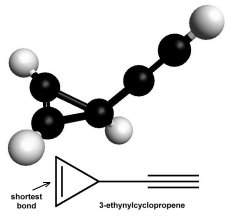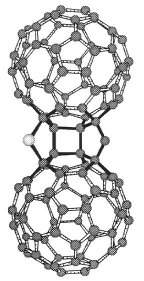Dubious X-rays
 Last
year, Mike Haley (University of Oregon) teamed up with Roland Boese (Essen), and Jay Siegel and Kim Baldridge (University of California San Diego) to report the synthesis and X-ray structure of a molecule with a
curiously short carbon-carbon double bond, 7 picometres less than that
in ethene. (Chem. Commun., 1998, 1137)
Last
year, Mike Haley (University of Oregon) teamed up with Roland Boese (Essen), and Jay Siegel and Kim Baldridge (University of California San Diego) to report the synthesis and X-ray structure of a molecule with a
curiously short carbon-carbon double bond, 7 picometres less than that
in ethene. (Chem. Commun., 1998, 1137)
The molecule, prepared by Haley, 3-ethynylcyclopropene, contains a
highly strained carbon ring with an adjacent triple bond. Not only was
it surprising that Boese measured the double bond at just 125.5 pm, but
when Siegel and Baldridge used fast
 computational
quantum mechanics to simulate it, the same bond was predicted to be
longer, at about 128 pm. 'The team worked hard to resolve even this
small discrepancy,' says Siegel. Boese checked the X-ray and Baldridge
and Siegel checked their theoretical data but it stubbornly stuck.
computational
quantum mechanics to simulate it, the same bond was predicted to be
longer, at about 128 pm. 'The team worked hard to resolve even this
small discrepancy,' says Siegel. Boese checked the X-ray and Baldridge
and Siegel checked their theoretical data but it stubbornly stuck.
'Although the discrepancy may seem small, the magnitude of the
difference is well beyond the expected uncertainties of the two
approaches, explains Paul Schleyer (University of Georgia, Athens),
'Something had gone wrong, either the theory was inadequate or the
experiments were inaccurate.'
Theoretical chemist Schleyer, working with Henry Schaefer III,
could not let this discrepancy lie. They reinvestigated the detailed
structure to the highest practicable computational levels with an
accuracy of 0.8 pm for related gas phase molecules. They expected
essentially exact bond lengths, but, the discrepancy got even worse when
they bumped up the theory 'level' with the double bond being 4.1 pm
longer than the X-ray result. An expert crystallographic referee
re-examined the X-ray data but found no errors. 'Geometry changes
between the solid state and the gas phase seem unlikely,' says Schleyer,
'The only conclusion is unsatisfying: there is no plausible explanation
at this time.'
Siegel agrees that the discrepancy is annoying but adds that
Schleyer's study is not too different from his and that the overriding
message is that cyclopropene derivatives do have short double bonds. He
has not ruled out geometry differences between the solid and gas phases.
The next step will be an experimental reinvestigation using neutron
diffraction and gas phase methods. 'If the 125.5 pm X-ray length stands
up to scrutiny then it may be necessary to reduce the confidence in the
quantitative performance of current chemical theory,' says Schleyer.
Siegel is a bit more reticent, 'This discrepancy may be the pea beneath
the princess' mattress,' he says, 'but I doubt it is the horn at the
walls of Jericho!'
Best yet catalyst
Alain Roucoux and his colleagues at ENS Chimie Rennes have developed a new liquid-liquid system based on rhodium metal particles just a few nanometres in diameter suspended in water to form a colloid. The second phase is the aromatic reactant and its products so no solvent is needed.
The system efficiently hydrogenates benzene and its derivatives to their cyclohexane equivalents. 'This is a new reaction system of industrial importance,' says Roucoux.
Previous efforts to develop biphasic catalysts, which allow the catalyst and product to be separated easily, require more drastic temperatures and pressures. This system appears to be the most efficient for converting benzene to cyclohexane and toluene, cumene, anisole and phenol to their hydrogenated forms in very mild conditions. (Chem. Commun., 1999, 535) Toothpaste tube
 Sodium
and potassium transport channels in cell membranes are shaped like a
toothpaste tube according to the X-ray structure of a transmembrane
potassium channel protein. A model being developed by UK researchers to
explain these ion channels' selectivity could help in understanding cell
ionic equilibria in diseases such as muscular dystrophy and why ion
transport fails, as happens in mercury and thallium poisoning.
Sodium
and potassium transport channels in cell membranes are shaped like a
toothpaste tube according to the X-ray structure of a transmembrane
potassium channel protein. A model being developed by UK researchers to
explain these ion channels' selectivity could help in understanding cell
ionic equilibria in diseases such as muscular dystrophy and why ion
transport fails, as happens in mercury and thallium poisoning.Peter Cragg and his colleagues at the University of Brighton and Jon Steed's team at King's College London believe that the sodium selective channel works in a similar fashion to the potassium channel. They have modelled the transport process using calixarene molecules, replicating the sodium selectivity of the natural membrane. Sodium ions pass through the model compound in dissolved form along its length, however, potassium ions are too large and are excluded. 'Crystallographic structures of sodium channels have yet to be determined so the mechanism is poorly understood,' explains Cragg, 'Our work assumes that the sodium selectivity filter will be analogous to that of potassium and the model reflects that structure.'
(Chem. Commun., 1999, 553)
 Wolfgang
Kr�tschmer one of the scientists who first isolated and identified
buckminsterfullerene has come up with a way to couple two of the carbon
soccerballs together using oxygen and sulphur for the first time. The
resulting bucky dumbbells could form the building blocks for novel
fullerene materials with interesting optical and electronic properties
or novel polymeric materials.
Wolfgang
Kr�tschmer one of the scientists who first isolated and identified
buckminsterfullerene has come up with a way to couple two of the carbon
soccerballs together using oxygen and sulphur for the first time. The
resulting bucky dumbbells could form the building blocks for novel
fullerene materials with interesting optical and electronic properties
or novel polymeric materials.